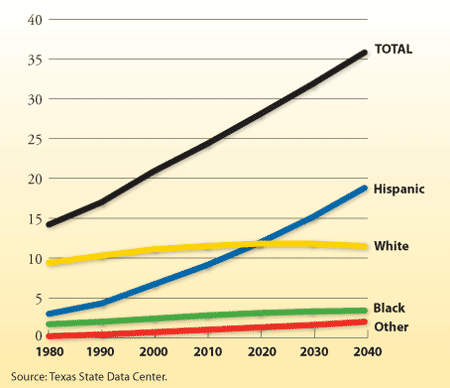The big suits in Washington are currently licking their chops in anticipation of passing a monstrous immigration bill that would increase US population by tens of millions over the next decade. Jamming in a Canada-sized bunch of new shoppers should goose up the GDP pretty good, business types agree!
Meanwhile out in the country, the inconvenient physical limits of the natural world are intruding. Texas has intermittent lengthy droughts anyway, and an escalating population, fueled by immigration, stresses the available water supply still further.
![]()
Out in West Texas, the present water shortage is considered extreme — check out the US Drought Monitor Map, updated weekly. As a result, towns like Odessa and Midland have decided to embrace water recycling, called “toilet to tap” by some skeptics.
The psychological ick factor has blocked some attempts to implement reclaimed water, because it means trusting the government to turn sewage into safe drinkable water. However in Orange County California, the recycled water is piped into local groundwater recharge basins, where it will eventually be pulled back for use.
As the population grows to environmentally unsustainable levels to please business and Democrat elites, the public will be increasingly have to pay for expensive water recycling technology. It’s another hidden cost of destructively high levels of immigration, along with schools and welfare to name a couple.
Today, in drought-stricken Texas, people are desperate for water. You can’t live on whiskey.
‘Eau de Sewage’ seen as water solution in parched West Texas, WFAA-TV Dallas, May 8, 2013
BIG SPRING –– In a parched corner of Texas four hours west of Fort Worth, water supplies are drying up. But ideas to replenish them are not.
Near Midland lies what used to be a peninsula, a spot that was once nearly surrounded by a sprawling reservoir. But almost the entire lake has evaporated. Years of drought have created a desperate thirst; the area remains in an extreme drought.
Is it desperate enough, though, for residents in Odessa, Big Spring, Snyder, Midland and Stanton to accept a solution that some find hard to swallow?
The Colorado River Municipal Water District recently began recycling millions of gallons of sewage.
After the sewage is scrubbed at the wastewater plant in Big Spring, the liquid is pumped into a new $12 million washing warehouse where it goes through micro-filters and reverse osmosis. Then, it’s disinfected with hydrogen peroxide and ultraviolet light.
“You are basically looking at bottled water quality water,” said operations manager John Womack. He contends what once went down a drain is pure enough to drink.
But for those who aren’t so confident, the water will be treated again before it’s consumed by the half million customers down the pipeline.
Still, Womack and his boss have heard all the wisecracks.
“We’ve been titled ‘from toilet to tap,’” Womack quipped.
“I heard somebody say they get to drink their beer twice now,” said general manager John Grant.
He expected some of that. As far as he knows, his is the first water district in the country to directly recycle effluent back into the reservoir. But he knows of other utilities that are seriously considering it.
“We have to get creative. We have to look for new sources and supplies,” Grant said. “It’s drought-proof. As long as the city is still there, the source will be there, and if the city grows, the supply grows.”
Ultimately, this recycling tactic may have the unintended effect of encouraging water conservation.
“I won’t drink it,” exclaimed Big Spring resident Pete Rosenbaum, “I am going to buy bottled water.”
Some locals still can’t get past the image that part of what’s in their cup may have once been swirling down a bowl, said resident David Jansch.
“The state even says it’s pure,” he said. “I understand that, but I know where it came from.”
For those who are concerned about pharmaceuticals, water district managers say the technology will get the bulk of any disposed medicines out of the water.
“Does it get it all? Maybe not,” Grant conceded.
But he adds that the heavily-cleansed water product is greatly diluted with “raw” water in the environment before it is piped to member cities, which then treat the water again.













